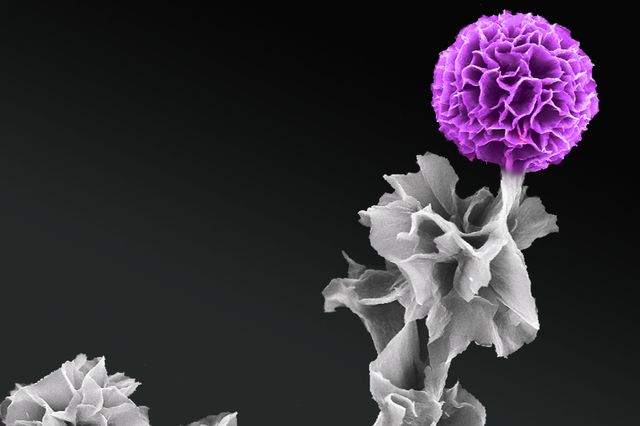Oct 6 2015
A method of growing semi-conducting crystals vertically has been developed. It is hoped that this method will increase both the power and efficiency of organic semiconductors. The new method could also be used in the production of more energy efficient solar panels.
 In full bloom: A scanning electron microscopy image produced by Jessica Wang of a vertical tetraanaline semiconductor crystal.
In full bloom: A scanning electron microscopy image produced by Jessica Wang of a vertical tetraanaline semiconductor crystal.
An increase in the efficiency of semiconductors has led to significant advancements in smartphones, computers and other such devices. Typically, inorganic semiconductors are produced using silicon or metal-oxides; however, they are expensive.
Researchers are interested in the development of carbon-based or organic semiconductors as they are abundantly available, economical and lightweight.
The study team, which was led by Richard Kaner, a distinguished professor of chemistry, materials science and engineering, successfully created an advanced structure for tetraaniline. Tetraaniline is a conductive polymer building block that behaves as a type of organic semiconductor.
In this experiment it was demonstrated that it was possible to grow tetraaniline crystals vertically.
This breakthrough could help advance solar energy technology as it would allow solar cells to take on a completely new shape. They could be created in the form of 'light antennas' that would be able to absorb light coming from all directions. Flat panels that are presently being used are capable of absorbing light only on a single surface.
In this study, tetraaniline crystals were grown vertically from a substrate, resulting in crystals that stand up vertically. The crystals were produced in graphene substrate solution. Before scientists have successfully grown vertical crystals in inorganic semiconducting materials; however, it is more difficult in organic materials.
Tetraaniline has chemical and electrical properties make it a promising candidate as a semiconductor. Tetraaniline has very small crystals and their orientation determines its properties. When crystals can be grown vertically, more of them can be packed in the semiconductor, and this increases their efficiency in controlling electrical currents. This behaviour makes them favorable for solar cells, photosensors and other such devices.
“These crystals are analogous to organizing a table covered with scattered pencils into a pencil cup. The vertical orientation can save a great deal of space, and that can mean smaller, more efficient personal electronics in the near future
Yue “Jessica” Wang - UCLA and Stanford University
After the team successfully found that they were able to sufficiently control the tetraaniline solution to grow in the form of vertical crystals they developed a method that utilized the same graphene substrate to grow crystals vertically in a highly ordered manner.
“The key was deciphering the interactions between organic semiconductors and graphene in various solvent environments. Once we understood this complex mechanism, growing vertical organic crystals became simple.
Yue “Jessica” Wang - UCLA and Stanford University
Another significant advantage of the graphene substrate was also discovered by the team:
This technique enables us to pattern crystals wherever we want. You could make electronic devices from these semiconductor crystals and grow them precisely in intricate patterns required for the device you want, such as thin-film transistors or light-emitting diodes.
Yue “Jessica” Wang - UCLA and Stanford University
The study paper has been published in the journal, ACS Nano.
The Boeing Company, the U.S. Department of Energy, the National Science Foundation, and the Defense Threat Reduction Agency, supported the study.